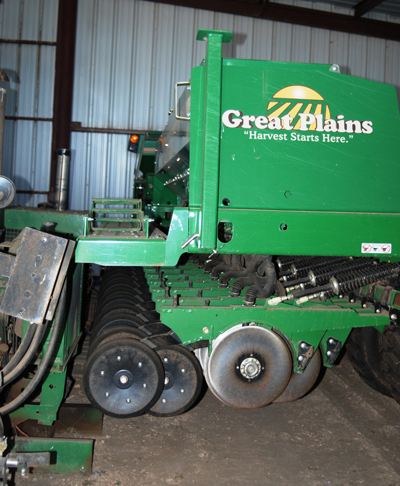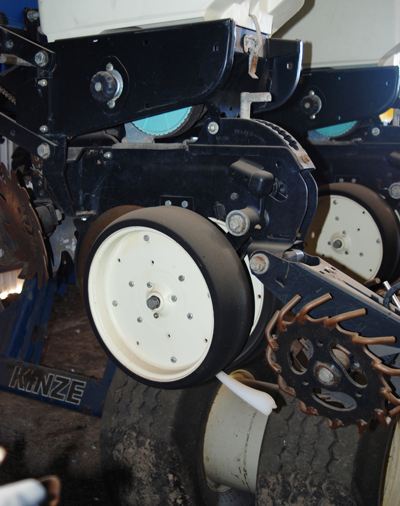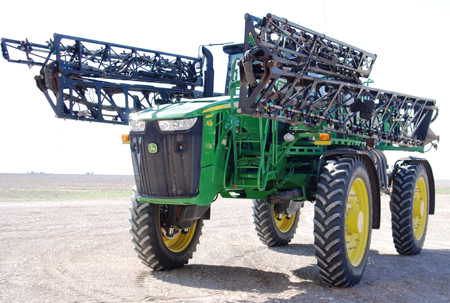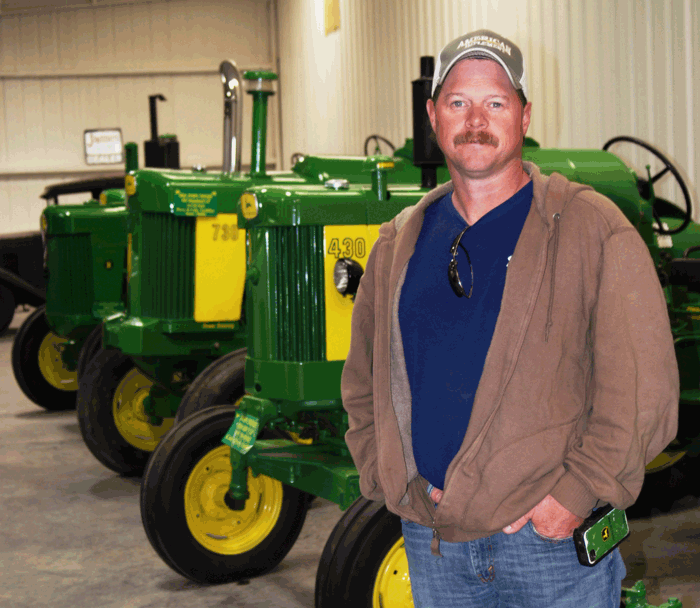ABOVE PHOTO: Cody Gruhlkey says a positive mindset was needed to adopt no-till on the majority of his family’s 8,000-acre farm near Kress, Texas, where they raise mostly cotton and wheat and plan to try dryland corn this spring. “To succeed in no-tilling you have to get your mind set to it. When you make peace with yourself that it’s all up to Mother Nature, it takes a lot of stress off of you,” he says.
Figuratively speaking, you could say that 17 years of no-tilling has grown Cody Gruhlkey a barnful of beautifully restored antique tractors on his 8,000-acre farming operation near Kress in the Texas Panhandle.
With the time and labor savings he’s realized from no-tilling, Gruhlkey has plenty of opportunity to work on farm equipment and to pursue his passion for restoring antique tractors when he’s not tending to cash crops.
“We’re not plowing and ripping all winter any more. I have the chance to work on my own antique tractors, and to do custom paint work for other antique tractor fanciers,” Gruhlkey says.
No Crusting
Teamed with his father, one full-time farm hand, and one part-timer, Gruhlkey no-tills 6,000 dryland and 2,000 irrigated acres in primarily a wheat-cotton-fallow rotation, although he sometimes plants grain sorghum and will try some dryland corn this season.
Cotton is the primary money maker on their farm and the cover afforded by wheat makes cotton work. Wheat is normally seeded into standing cotton stalks immediately after cotton harvest with a Great Plains 3-S-4000 HD minimum-till drill with hydraulic down pressure and opening discs on 7½-inch spacings.
The seeding rate is 30 pounds per acre dryland and 60 pounds per acre on irrigated land.

This Great Plains 3-S-4000 HD minimum-tillage drill, with hydraulic down pressure and opening discs, allows Cody Gruhlkey get wheat seeded into standing cotton stalks as soon as his two John Deere 7460 cotton strippers leave the field.
“We realize wind-erosion protection, water savings, and we don’t have to run a rotary hoe to break the crust and help the cotton crop emerge, because the soil doesn’t crust with no-till,” Gruhlkey says.
“It was a little scary getting started in no-till. We saw a slight drop in yields the first couple of years, and about three years in the soil got hard. Then, suddenly, the soil opened back up and the yields came back. We couldn’t farm nearly the acres we do today, with the help we have, if not for no-till.”
He gets by with small row-crop tractors that show low hours of use and fuel savings. He makes good use of a John Deere 4940 self-propelled sprayer rigged with a 120-foot boom and 1,200-gallon tank. Gruhlkey says he can get across as much as 225 acres in an hour — 1,800 acres a day by himself with the spray rig, running 18-20 mph in some situations.
Gruhlkey has been a stickler for a rotation of 1/3 wheat, 1/3 cotton, 1/3 fallow since he started in no-till. On irrigated acres he plants half wheat and half cotton. When they finish up cotton harvest in the late fall they already pretty-well know what the following year’s acreage will be and stick with that. He notes it takes a long time to harvest 2,500-3,000 acres of cotton a year, even with their two John Deere 7460 eight-row cotton strippers.
“Having dryland grain in the rotation eases the harvest load with cotton,” Gruhlkey says.
At fall seeding, he applies Ally on all wheat acres, right behind the drill, locking in an 18-month rotation that leads back to cotton.
“Ally leaves us not tempted to jump out of our rotation or alter acreage. Should the wheat crop fail, I have to fallow,” he says.
Fighting Weeds

A Kinze planter with row units set up to 20-inch spacings will be used by Cody Gruhlkey to plant dryland corn this spring. Each unit has Schlagel spiked closing wheels, and can also be used for sorghum planting.
He’s considered using tillage radishes, or another cover crop, in lieu of fallow on cotton ground hard-packed by harvesting equipment, but has been wary of the expense and the possible moisture use ahead of wheat.
After wheat harvest he applies Valor, and uses Banvel and Roundup to control volunteer wheat and weeds in the wheat stubble.
Valor, a residual, helps with control of marestail and tansy mustard. In early spring, 45 days before cotton planting time, Gruhlkey applies 2,4-D to control escaped weeds. Direx and Dual are applied on cotton right behind the planter.
Gruhlkey says he’s not having trouble with resistant pigweed, and believes his rotation and use of a variety of herbicides is the reason. He’s found that reducing the amount of water in the spray mix is effective on tough weeds.
“An old timer here once told me you couldn’t kill weeds with water. At one time, I used 15-20 gallons of water an acre in the spray mix. Now I’m only using 4 or 5 gallons, so the chemical is more concentrated. I’m even having success killing Russian thistle — but we have to get the weeds while they’re small. We use low-drift nozzles on the sprayer.”
Rather than hauling water to the field for spraying, Gruhlkey relies on a 12,000 gallon fresh-water tank and filling facilities at his farm headquarters where he can easily open chemical containers and triple rinse in the process of filling.
“With my spray rig I can road to headquarters fast and refill without the hassle of hauling water around to different fields,” he explained.
Stalwart Cotton
Cotton is planted on 40-inch rows using a 16-row John Deere 1710 planter with heavy pneumatic down pressure. Keeton seed firmers are rigged behind the seed tubes, and Schlagel spiked closing wheels cover the seed.
Originally he ran Sunco trash whippers on the planter but removed those once he began using a stripper header on his John Deere S-670 combine during wheat harvest. He aims for a dryland cotton population of 25,000 plants per acre, and 50,000 plants per acre in irrigated cotton.
“We’re not after coffee-shop cotton yields. We try for 2½ bales per acre on irrigated cotton and feel like we’ve hit a home run if we get 3 bales an acre,” Gruhlkey says. “We feel like that’s reasonable for our available water.”
Gruhlkey notes that from 2007 to 2010 they had some really good years and made 700-900 pounds of lint per acre on dryland cotton — and probably couldn’t have made much more even if they poured on more inputs.
“We’re not high input farmers — we’re satisfied with decent yields,” he says. “We figure cotton from all directions, and by the time we figure in the dividends from the cooperative cotton compress, and the cooperative oil mill where we are members,cotton proves worth more than you would think and pays the most for our limited irrigation inputs.”
For the dryland corn he’s planting this year, as well as for dryland sorghum, he’ll use a Kinze 20-inch planter. They’re shooting for 13,000-14,000 plants per acre for dryland corn and will plant early using a 108-day variety — Pioneer 0876 with a flex ear — to have the best yield potential.

A John Deere 4940 sprayer with 120-foot boom and 1,200-gallon tank lets Texas no-tiller Cody Gruhlkey get across acres fast. He’s sprayed as many as 1,800 acres in a day by himself. He’s realizing good control of even problem weeds by cutting back on water and hitting weeds with a more concentrated herbicide mix.
They will plant in solid 20-inch rows rather than skipping any rows in the dryland setting.
“If we can make dryland corn work it has the potential to return more than grain sorghum and will give us another cropping option,” Gruhlkey says.
His top dryland wheat yield is 50 bushels per acre, and this year’s crop offers such potential, depending on spring rainfall.
Making No-Till Work
The yeoman piece of equipment is his wheat farming is a Shelbourne-Reynolds stripper header on the combine.
“Once we started using a stripper header we noticed a more even stand in the following crop, with no cold spots in the field to hurt germination,” he says. “We normally harvest our wheat, even if the dryland yield is light. There’s not much residue left in 5-10 bushel wheat, but the stripper header leaves more of it for us to use.”
They harvest 2,500- 3,000 acres of their own wheat before doing another 1,000 acres of custom wheat harvest work.
“We’ve been making better wheat yields with this no-till rotation. Sometimes the wheat yields aren’t a lot, maybe as little as 10 bushels an acre if we don’t get good rainfall, but they are improving, and the residue from the harvested wheat is important to us,” Gruhlkey says. “To succeed in no-tilling you have to get your mind set to it. When you make peace with yourself that it’s all up to Mother Nature, it takes a lot of stress off of you.
“We’re succeeding in making dryland no-till work. In fact, we might be all dryland today if we could. During the summer months we’re dealing with keeping 56 irrigation wells, averaging 80-100 gallons per minute, in operation. Our costs per acre-inch of water are reasonable, but when you deal with all of the flats, gearboxes and drive shafts on all of the sprinkler pivots, it gets to be work.
“Our shift to dryland no-till has put us years ahead of other producers in the region.”







Post a comment
Report Abusive Comment